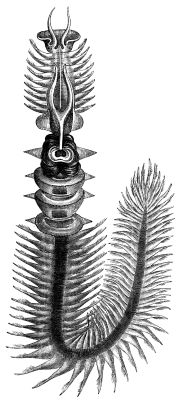Photoprotein
Photoproteins are a type of protein that emit light upon binding with a specific ligand. This phenomenon is known as bioluminescence, a process that allows living organisms to produce light. Photoproteins are found in a variety of bioluminescent organisms, including certain species of jellyfish, worms, and coelenterates. They play a crucial role in various biological processes, such as predation, defense, and mating.
Overview
Photoproteins are distinct from other light-producing proteins, such as luciferase, in that they require a specific cofactor to emit light. The reaction is typically oxygen-independent and involves the binding of the cofactor to the photoprotein, which leads to an enzymatic reaction that produces light. The most well-known photoprotein is aequorin, which is derived from the jellyfish Aequorea victoria. Aequorin emits blue light upon binding with calcium ions, making it a valuable tool in biological research for studying calcium signaling in cells.
Mechanism
The mechanism of light emission in photoproteins involves a series of steps: 1. The photoprotein is in a stable state until it binds with its specific cofactor. 2. Upon cofactor binding, a conformational change occurs in the protein structure, leading to the activation of the light-emitting reaction. 3. The reaction typically involves the oxidation of the cofactor, resulting in the release of light. 4. After the reaction, the photoprotein returns to its ground state, ready to bind another cofactor molecule.
Applications
Photoproteins have various applications in scientific research and biotechnology. They are used as biomarkers for tracking gene expression and protein localization within cells. In calcium imaging, photoproteins like aequorin are utilized to monitor calcium levels in living cells, providing insights into cellular processes that involve calcium signaling. Additionally, photoproteins are explored for their potential in medical diagnostics, environmental monitoring, and as non-toxic light sources in bioluminescent imaging.
Challenges and Future Directions
While photoproteins offer promising applications, there are challenges in their use. The sensitivity and stability of photoproteins can be affected by various factors, including temperature and pH levels. Moreover, the production and purification of photoproteins can be complex and costly. Future research is focused on overcoming these challenges by engineering more stable and sensitive photoproteins and developing efficient methods for their production and purification.
See Also
This article is a biochemistry stub. You can help WikiMD by expanding it!
Transform your life with W8MD's budget GLP-1 injections from $125.
W8MD offers a medical weight loss program to lose weight in Philadelphia. Our physician-supervised medical weight loss provides:
- Most insurances accepted or discounted self-pay rates. We will obtain insurance prior authorizations if needed.
- Generic GLP1 weight loss injections from $125 for the starting dose.
- Also offer prescription weight loss medications including Phentermine, Qsymia, Diethylpropion, Contrave etc.
NYC weight loss doctor appointments
Start your NYC weight loss journey today at our NYC medical weight loss and Philadelphia medical weight loss clinics.
- Call 718-946-5500 to lose weight in NYC or for medical weight loss in Philadelphia 215-676-2334.
- Tags:NYC medical weight loss, Philadelphia lose weight Zepbound NYC, Budget GLP1 weight loss injections, Wegovy Philadelphia, Wegovy NYC, Philadelphia medical weight loss, Brookly weight loss and Wegovy NYC
|
WikiMD's Wellness Encyclopedia |
| Let Food Be Thy Medicine Medicine Thy Food - Hippocrates |
Medical Disclaimer: WikiMD is not a substitute for professional medical advice. The information on WikiMD is provided as an information resource only, may be incorrect, outdated or misleading, and is not to be used or relied on for any diagnostic or treatment purposes. Please consult your health care provider before making any healthcare decisions or for guidance about a specific medical condition. WikiMD expressly disclaims responsibility, and shall have no liability, for any damages, loss, injury, or liability whatsoever suffered as a result of your reliance on the information contained in this site. By visiting this site you agree to the foregoing terms and conditions, which may from time to time be changed or supplemented by WikiMD. If you do not agree to the foregoing terms and conditions, you should not enter or use this site. See full disclaimer.
Credits:Most images are courtesy of Wikimedia commons, and templates, categories Wikipedia, licensed under CC BY SA or similar.
Translate this page: - East Asian
中文,
日本,
한국어,
South Asian
हिन्दी,
தமிழ்,
తెలుగు,
Urdu,
ಕನ್ನಡ,
Southeast Asian
Indonesian,
Vietnamese,
Thai,
မြန်မာဘာသာ,
বাংলা
European
español,
Deutsch,
français,
Greek,
português do Brasil,
polski,
română,
русский,
Nederlands,
norsk,
svenska,
suomi,
Italian
Middle Eastern & African
عربى,
Turkish,
Persian,
Hebrew,
Afrikaans,
isiZulu,
Kiswahili,
Other
Bulgarian,
Hungarian,
Czech,
Swedish,
മലയാളം,
मराठी,
ਪੰਜਾਬੀ,
ગુજરાતી,
Portuguese,
Ukrainian
Contributors: Prab R. Tumpati, MD

